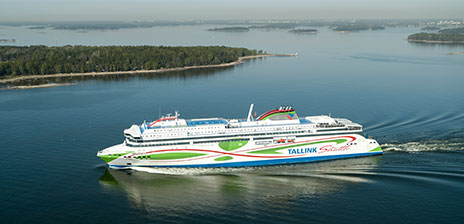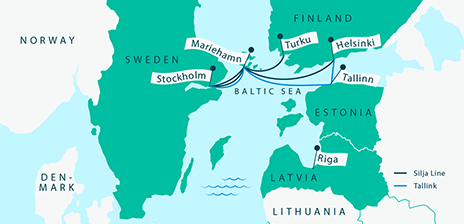A giant plug to supply
ship with power
Utilizing shore power during port stays makes ships
more environmentally friendly
By connecting vessels to shore-to-ship green power solution, the emissions produced by the vessel during port stay can be cut up to 50-80 percent, since the vessels auxiliary engine does not have to be kept working to produce power.
Shore power enables cooperation with ports
Ferries which are by comparison, equivalent to the size of a small town, travel regularly between our neighbouring country capitals. During port stays, the ships can connect to the shore-to-ship green power solution, which has a considerable impact on cutting the emissions and has the added advantage of cutting the noise in ports, which are close to city centres or dense areas of residence.
Shore power utilises electricity centrally produced in onshore power plants. Shore-to-ship green power solution was first launched in spring of 2019 in Port of Stockholm, Värtahamnen, on the Helsinki-Stockholm route for vessels Silja Serenade and Silja Symphony. In Helsinki, at the Port of Helsinki’s Olympia terminal, the shore-to-ship power solution will be ready in 2020 and West Harbour it will be completed during 2021. In Port of Tallinn’s Old City Harbour, the shore to ship green power solution will be completed and taken into use during 2020.
The giant plug that connects the ship to port will not be able to use the normal mains power. Therefore, cooperation with ports has been the key which has made utilising the shore-to-ship power solutions possible
Vessels must also be adjusted for using shore power
Utilising shore power solution is sensible for vessels whose port stays last longer than two hours, for example, for vessels operating on routes between Helsinki and Stockholm and during overnight port stays in Tallinn.
Silja Serenade and Silja Symphony are relatively older vessels. Nevertheless, at their construction time, those vessels were particularly technologically advanced. Already in the 1990s, when the shore power was not much talked about, both vessels were already built with capability to utilise shore power. From the technical side, both ships still had to undergo an upgrade to meet current standards. During the last docking, both ships were equipped with a high voltage transformer (11 kW), high-voltage cabling as well as circuit breakers were installed.
Shore-to-ship green power solution entails a fair amount of investment to the ship, which means that it makes economic sense that it is used in every port the ship routinely visits. At this time, the ships have used shore power in port of Stockholm since spring 2019. The Port of Helsinki is in process of building a new high-voltage shore power connection in Olympia terminal for the use of vessels operating between Stockholm. The brand new high-voltage shore power connection will be operational by the end of this year.
Efficient electricity at medium voltage
Centrally produced onshore power essentially means that a remotely controlled cable crane is installed in port which supplies vessels at medium voltage. This in turn, for example, means that the existing substation on at the port of Helsinki will have to have a facelift and the capacity of the whole port area will have to be raised from 0,5 MW to over 3 MW.
The onshore power upgrade investment at the Olympia terminal includes also automation design and technology, renovation of the existing substation, quay work and, most importantly, electricity system with its installations on the shore-side. On the side of Port of Helsinki, the amount of total investment is ca 1.8M EUR.
The South Harbour shore-side electricity investment will be introduced at the end of the year.
Sustainable Port Operations in Helsinki








